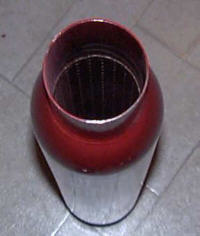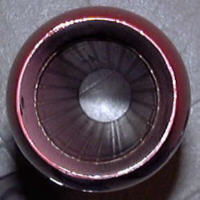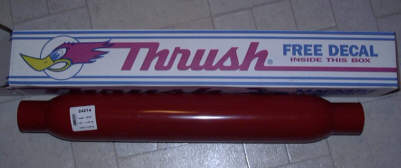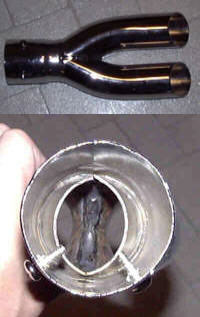|
Never Forget |
||||||||||||||||
|
|
||||||||||||||||
FAQ'sCloud Car Transmission Problems Cloud Car Performance Exhaust Cloud Car Performance Ignition Misc.Car InformationThe Society of Automotive Engineers Car EnthusiastsCar Parts Vendors |
Cloud Car Performance Exhaust FAQ
The below list represents a collection of commonly asked questions concerning the exhaust system. While meant specifically for enthusiasts who drive the Chrysler Sebring Convertible, Chrysler Cirrus, Dodge Stratus, and/or Plymouth Breeze, the concepts presented here can be applied to any vehicle. If you have any further questions about exhaust, please feel free to e-mail me, and I'll answer, and maybe even put the question into this list. Why mess with the exhaust system at all? The stock factory exhaust that comes with our cloud cars is very restrictive, and presents a lot of backpressure to the engine. Backpressure is a very bad thing, because it makes the engine work harder just to push out exhaust gases, and backpressure causes exhaust gases to stay around longer, heating up the engine in the process. No backpressure is good backpressure. Ideally, an internal combustion engine that had an exhaust system opened to a sustained high vacuum would be best for performance, but this is simply not possible. Barring that, a high performance exhaust system is such a system that presents as little restriction to exhaust flow as possible. The factory exhaust system will give anywhere from 7 to 12 PSIG of backpressure, while high-performance exhausts will give as little as 1 PSIG. There is one exception. If you're lucky enough to own a car with a turbocharger, well, guess what? That turbocharger, believe it or not, is a restriction. However, the restriction present in a turbocharger is necessary for the turbo to work at all, and the performance gain associated with the turbocharger more than makes up for the restriction the turbo presents to the engine exhaust. Even a turbo car can benefit from a performance exhaust, though. A cat-back exhaust refers to an exhaust system that has been completely replaced from the outlet of the catalytic converter by components able to flow more exhaust gas, which reduces backpressure. Oftentimes, the cat-back setup will include exhaust piping which is a size larger than stock (2.5" diameter as opposed to 2.25" for the factory exhaust). They also include high-flow performance mufflers (and resonators), with smooth Mandrel bends that minimize exhaust restriction. Is a louder exhaust a better exhaust? Not necessarily. While it is true that such an exhaust implies that there are no restrictions, there are sound considerations as well. A lot of vehicles sound, frankly, stupid with a loud exhaust. The general effect these vehicles have to bystanders is that they sound like they have a lawn-mower engine on steroids. Of course, there are local laws that concern themselves with exhaust noise, and the owner of a car with a very loud exhaust may end up getting a "fix-it" ticket, or pay a fine. Since loud exhaust is also a favorite of people more likely to speed, the local police will be more likely to give a speeding ticket to the owner of a loud car than the owner of a car with a quiet exhaust. Well, how can I get both a quiet exhaust and performance? Believe it or not, there are effective ways to quiet the exhaust while maintaining a reasonable performance gain over the factory exhaust system. Mufflers used in today's cars fall into three categories.
All three terms refer to the way that the muffler works. Restriction, as the name implies, quiets the exhaust by restricting the passage of exhaust gas. This is a really effective way to quiet the exhaust, but robs engines of performance something fierce. Absorption mufflers, on the other hand, try to keep the exhaust flow as free as possible while absorbing the sound waves in the exhaust with some sound-deadening material (typically fiberglass or steel wool). Reflection mufflers keep the exhaust flow free and use carefully-placed plates in their muffler bodies to reflect and cancel out the sound waves in the exhaust. Factory exhaust systems typically have mufflers that work using either restriction, or restriction and absorption. Restriction mufflers are generally very cheap to make, and last longer than absorption mufflers.
Now, one can select a good set of mufflers to reduce noise while still giving the performance so desired with our clouds. It's actually very simple: When considering a muffler for purchase, two things must be considerd. First, inspect the inside of the muffler (called the core). If the core looks very smooth with a bunch of small drilled holes, and it is possible to see out the muffler, this is a good candidate.
Also, ensure that the core diameter is the same as the diameter of the exhaust pipe being used. Remember that a diameter reduction is the same as a restriction. Stay away from any core that has a bunch of louvers (these mufflers will have a marked inlet and outlet), and don't be conned by anybody that says that muffler can be installed backwards. Louvers are a bad performance design since they present restriction to the exhaust flow.
The picture to the left is of a Thrush Magnum Glasspack muffler, P/N 24214. Total length is 28", with 2.5" inlet and outlet diameters. The two pictures used above were also from this muffler. Note that with this type of muffler, there is no real distinction between the inlet and outlet ports. Can I get rid of the catalytic converter? If the catalyic converter were removed, the vehicle would be in violation of Federal emissions laws, and the owner could be subject to EPA fines. Additionally, cloud cars have both an upstream oxygen sensor to monitor engine combustion, and a downstream oxygen sensor that measures how well the catalytic converter is working. Normally, the readings of both oxygen sensors are different. If the cat were removed, both oxygen sensors would read the same, and this tells the PCM that there's something wrong with the cat. The PCM would then light the "Check Engine Soon" light. Federal Law mandates a 5-year warranty on catalytic converters that is separate from the warranty covering the rest of the car. By law, the only way that the cat can be replaced is if it clogs up or physically breaks, and then that has to be documented by an authorized mechanic and sent off to paper-pushing bureaucrats. Since both conditions are unlikely for new cars, cats are seldom changed out on cloud cars. In any case, the cat present with our cloud cars is more than adequate for the time being. They are designed to flow approximately 2-3 times the normally expected maximum exhaust flow produced from our cloud's engines, and in normal use will cause a 1 or 2 PSID resistance to exhaust flow. This is in comparison to the 7-10 PSID resistance caused by the rest of the exhaust system. Now, there are available for the general public "high-flow" catalytic converters. They generally run around $100, and will cost around $80 to install. However, because of the law, the existing cat must be bad in order to replace it, and some mechanics will insist on a "authorized" OEM-style replacement cat. The bottom line is: Removing the catalytic converter is a bad idea, both in terms of civil liability and in terms of performance gains. How big a diameter of exhaust pipe should I run? An exhaust pipe diameter of more than 2.5" presents a few problems. First, exhaust gas is pretty hot when it comes out the engine, and as such, isn't very dense. This means that the exhaust gas will be faster and won't have to have as much work done on it to move it out the tailpipe. Now, if a larger pipe is installed, the exhaust gas will slow down due to the increased volume it gets to flow through, and it will also have a smaller restriction it has to overcome compared to a smaller diameter pipe. This is good, up to a point. An exhaust that has to slow down too much, such as from a too-large pipe selection, will spend a long time in the pipe and cool down. This makes the exhaust gas more dense, and will cause the engine to work harder to push the gas out the tailpipe. Second, there is the problem of physically mounting the pipe underneath the car. A high-performance system will include bends that are free of stress kinks, and are generally smooth. These bends have to have some sort of minimum bend radius which varies as a function of pipe diameter. If the bend radius of the pipe is too small compared to its diameter, it poses a restriction. Now, pipes larger than 2.5" diameter have a bend radius that won't comfortably fit under the car. It quickly becomes an exercise in frustration to try to fit such a pipe under the car. Finally, weight is a consideration. Larger pipes weigh more. Presumably, the idea for replacing the factory exhaust with a larger high-performance one was to have performance in mind. Well, an overly large diametered exhaust will weight so much that it'll affect the car's acceleration. This weight will also have to be supported by more hangers underneath the car. What are some examples of exhaust restrictions?
These two pictures are of a commonly found exhaust tip that gives the appearance of dual exhaust pipes. While it looks shiny and cool, notice that the inlet shows about a 20% restriction to exhaust flow. It may look cool, but it is definitely not a performance enhancer.
This picture is an example of the type of pipe bend one can expect from any major auto parts store, or from any major retail exhaust service center. Note the really neat stress kinks on the inside of the bend, as well as the diameter reduction of the bend itself. This type of bend will reduce the diameter of the pipe by about 15%. Some say that "an engine needs backpressure to work correctly." Is this true? No. It would be more correct to say, "a perfectly stock engine that cannot adjust its fuel delivery needs backpressure to work correctly." This idea is a myth. As with all myths, however, there is a hint of fact with this one. Particularly, some people equate backpressure with torque, and others fear that too little backpressure will lead to valve burning. The first reason why people say "backpressure is good" is because they believe that increased backpressure by itself will increase torque, particularly with a stock exhaust manifold. Granted, some stock manifolds act somewhat like performance headers at low RPMs, but these manifolds will exhibit poor performance at higher RPMs. This, however does not automatically lead to the conclusion that backpressure produces more torque. The increase in torque is not due to backpressure, but to the effects of changes in fuel/air mixture, which will be described in more detail below. The other reason why people say "backpressure is good" is because they hear that cars (or motorcycles) that have had performance exhaust work done to them would then go on to burn exhaust valves. Now, it is true that such valve burning has occurred as a result of the exhaust mods, but it isn't due merely to a lack of backpressure. The internal combustion engine is a complex, dynamic collection of different systems working together to convert the stored power in gasoline into mechanical energy to push a car down the road. Anytime one of these systems are modified, that mod will also indirectly affect the other systems, as well. Now, valve burning occurs as a result of a very lean-burning engine. In order to acheive a theoretical optimal combustion, an engine needs 14.7 parts of oxygen by mass to 1 part of gasoline (again, by mass). This is referred to as a stochiometric (chemically correct) mixture, and is commonly referred to as a 14.7:1 mix. If an engine burns with less oxygen present (13:1, 12:1, etc...), it is said to run rich. Conversely, if the engine runs with more oxygen present (16:1, 17:1, etc...), it is said to run lean. Today's engines are designed to run at 14.7:1 for normally cruising, with rich mixtures on acceleration or warm-up, and lean mixtures while deccelerating. Getting back to the discussion, the reason that exhaust valves burn is because the engine is burning lean. Normal engines will tolerate lean burning for a little bit, but not for sustained periods of time. The reason why the engine is burning lean to begin with is that the reduction in backpressure is causing more air to be drawn into the combustion chamber than before. Earlier cars (and motorcycles) with carburetion often could not adjust because of the way that backpressure caused air to flow backwards through the carburetor after the air already got loaded down with fuel, and caused the air to receive a second load of fuel. While a bad design, it was nonetheless used in a lot of vehicles. Once these vehicles received performance mods that reduced backpressure, they no longer had that double-loading effect, and then tended to burn valves because of the resulting over-lean condition. This, incidentally, also provides a basis for the "torque increase" seen if backpressure is maintained. As the fuel/air mixture becomes leaner, the resultant combustion will produce progressively less and less of the force needed to produce torque. Us cloud-car owners don't have to worry too much about the effects described above, because the PCM that controls the engine in a cloud car will detect that the engine is burning leaner than before, and will adjust fuel injection to compensate. So, in effect, reducing backpressure really does two good things: The engine can use work otherwise spent pushing exhaust gas out the tailpipe to propel the car foward, and the engine breathes better. Of course, the PCM's ability to adjust fuel injection is limited by the physical parameters of the injection system (such as injector maximum flow rate and fuel system pressure), but with exhaust backpressure reduction, these limits won't be reached. Can I use dual exhausts with my cloud? Strictly speaking, no. Dual exhausts were meant for vehicles that have separate banks of cylinders (opposed or V configurations), with the dual exhaust being separate (except for an H- or X-pipe) straight from the engine back to the rear end of the vehicle. Our cloud cars simply don't have the underbody clearance for such an extravagance. However, it is possible to have dual exhaust mufflers and tips to give the impression of a dual exhaust. Installation is pretty simple, and the branch can be tapped off the U-bend positioned around the right rear suspension. Dual setups will only give a slight performance increase over a single muffler, since the exhaust already had to travel through most of the bends in the system to begin with, and may have had to pass through the resonator, but it sure will change the sound of the exhaust coming out the tailpipes. A header is an exhaust component that bolts onto the engine and takes place of the stock exhaust manifolds. Headers come in a variety of designs, but all perform the same function of scavenging exhaust gases out of the combustion chamber. To understand how a header works, an analysis of how exhaust leaves the engine is in order. Exhaust is composed of separate pulses, with each pulse consisting of a high-pressure front, a middle at about ambient pressure, and a low pressure rear. As RPM's go up, more and more of these pulses are produced. Now, a stock exhaust manifold tends to jam these pulses together haphazardly in order to stuff them into the tailpipe. This has the unfortunate effect of creating backpressure. Now, a header works to gently combine these pulses together so that they help each other leave the engine. Remember how an exhaust pulse is made up. Now, if the low-pressure tail end of one pulse were to help the high-pressure front of the next pulse leave the engine, that would allow the next pulse to leave the engine much better than if these pulse were simply jammed together. This is exactly how a header works. The scavenging effect induced helps to suck out exhaust gases from the combustion chamber, reducing the amount of work the engine has to do to push out gas, and allows more fuel/air mixture to be sucked into the combustion chamber. Headers generally have lengths of pipe (called runners) that are equal length, with these lengths so measured so as to cause peak torque at a certain RPM range. Long, thin runners will bump up low end RPMs and have a wide RPM band, while shorter, wider runners increase high end RPM performance with a narrower RPM band. The wide runners generally have the unfortunate effect of dropping low-end torque. Why is this? As the tail end of each pulse leaves the runner and goes into the collector, a high-pressure spike gets induced into the other runners in that header. Now, if this high-pressure spike were to hit the exhaust valve for another combustion chamber as it was opening (or already open), the result would be a backpressure transient that would pose a restriction to that pulse that was trying to leave. Narrow runners, on the other hand, give great low-end torque at the expense of high-end power. This is simpler to explain, simply because the runners are too narrow for more than a little bit of flow at a time. There are headers designed with anti-reversion (AR) cones available. The principle that AR works by is this: AR cones in each runner speed up the exhaust pulse, then empty the pulse into a relatively wide runner. The cone effectively blocks the high-pressure spike, substantially reducing the associated backpressure transient, while allowing the pulse to increase velocity without becoming restricted in the process. The result is a header that produces great low-end torque and high end power, with a wider RPM band than would be possible otherwise. Keep in mind, though, that neither the torque nor the peak power produced with AR headers are as much as could be produced with traditional headers that were tuned for either low-end torque or high-end power. It is interesting to note that some stock factory exhaust manifolds are so good at ramming pulses together (such as the manifolds on the 2.5L V-6) that they act like low-end headers with the corresponding peak power drop. A resonator is the component in the exhaust system that muffles out the high-pitched components of exhaust noise, such as valve noise. It does this by using reflection to allow those high-pitched components to "resonate" away. The factory resonator does a good job at reducing this noise, but since it uses a small core, it also presents a restriction. An alternative to the stock resonator is to place a glass-pack muffler (such as the example shown above) in place of the stock resonator. The glass-pack muffler uses a more conventional absorbtion technique to get rid of the noise. Another alternative to using the resonator is to place a straight run of exhaust pipe in place of the resonator. Both alternatives will give a noticable performance increase over stock. Of note is the fact that, while performance may be marginally better with the straight pipe over using a glass-pack, the resultant exhaust noise will be much louder with the pipe. |
|||||||||||||||
|
Chrysler, the Chrysler logo, Dodge, and Mopar are registered trademarks of Fiat Chrysler Automobiles. Other trademarks and logos are copyrighted by their various owners. This website copyright © 2000-2015 Thomas A. Vago. All Rights Reserved. |
This page last updated 20 April 2010. | |||||||||||||||




